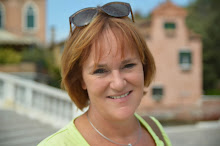Friedensreich Hundertwasser (1928-2000) was an Austrian artist and architect who is best known for the colorful buildings he designed, built with attention to the environment and nature. The buildings of Hundertwasser are very recognizable: straight lines are missing, there is use of bright colors and many of his buildings have typical turrets. The influence of architect Gaudi is obvious.
The paintings of Hundertwasser have exuberant colours too and mainly undulating lines.
Show buildings of Hundertwasser on the digital board. Discuss the salient features: bright colours, undulating lines. Then show some paintings and discuss the things that stand out:
• the use of small areas outlined with black
• no straight lines, usually parallel lines• recurring spiral shapes
• bright colours
Tell students they are going to draw means of transport in the style of Hundertwasser.
You need:
- drawing sheet
- pencil
- markers
Source: Dutch website Laat maar zien.











